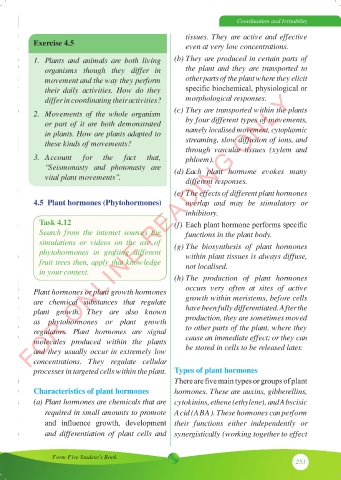Page 260 - Biology_F5
P. 260
Coordination and Irritability
tissues. They are active and effective
Exercise 4.5 even at very low concentrations.
1. Plants and animals are both living (b) They are produced in certain parts of
organisms though they differ in the plant and they are transported to
movement and the way they perform other parts of the plant where they elicit
their daily activities. How do they specific biochemical, physiological or
FOR ONLINE READING ONLY
differ in coordinating their activities? morphological responses.
2. Movements of the whole organism (c) They are transported within the plants
or part of it are both demonstrated by four different types of movements,
in plants. How are plants adapted to namely localised movement, cytoplasmic
these kinds of movements? streaming, slow diffusion of ions, and
through vascular tissues (xylem and
3. Account for the fact that, phloem).
“Seismonasty and photonasty are (d) Each plant hormone evokes many
vital plant movements”. different responses.
(e) The effects of different plant hormones
4.5 Plant hormones (Phytohormones) overlap and may be stimulatory or
inhibitory.
Task 4.12 (f) Each plant hormone performs specific
Search from the internet sources the functions in the plant body.
simulations or videos on the use of (g) The biosynthesis of plant hormones
phytohormones in grafting different within plant tissues is always diffuse,
fruit trees then, apply that knowledge not localised.
in your context.
(h) The production of plant hormones
Plant hormones or plant growth hormones occurs very often at sites of active
are chemical substances that regulate growth within meristems, before cells
plant growth. They are also known have been fully differentiated. After the
as phytohormones or plant growth production, they are sometimes moved
regulators. Plant hormones are signal to other parts of the plant, where they
molecules produced within the plants cause an immediate effect; or they can
and they usually occur in extremely low be stored in cells to be released later.
concentrations. They regulate cellular
processes in targeted cells within the plant. Types of plant hormones
There are five main types or groups of plant
Characteristics of plant hormones hormones. These are auxins, gibberellins,
(a) Plant hormones are chemicals that are cytokinins, ethene (ethylene), and Abscisic
required in small amounts to promote Acid (ABA). These hormones can perform
and influence growth, development their functions either independently or
and differentiation of plant cells and synergistically (working together to effect
Form Five Student’s Book
253

